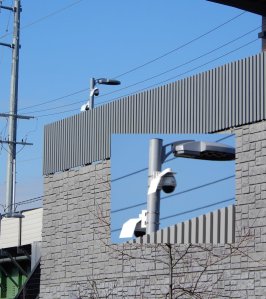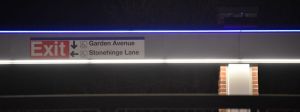
Carle Place residents list litany of concerns with LIRR project
The MTA announced that the LIRR Expansion Project has been completed and all the outstanding issues have been settled.
Residents of Garden Avenue in Carle Place, adjoining the railroad station, beg to differ.
The agency and its contractor, 3TC, laid down a third track, replaced bridges, eliminated grade crossings, erected parking garages and replaced/renovated stations along a 9.8-mile stretch of the main line between Floral Park and Hicksville. The project cost about $2.6 billion. The executive summary of the Final Environmental Draft Statement notes that the project’s primary purpose “is to improve rail service, reliability, public safety, and quality of life” along the main line.
Carle Place is unique among the seven stations in the expansion area in that it has the most private residences adjacent to and affected by station operations. Countering the claims of the executive summary, homeowners on Garden Avenue said the changes they have seen since the transformation of the local station have diminished their quality of life.

Craig Hymanson said if he knew then what he knows now, he never would have bought his home, whose backyard abuts the station. He has been a resident for about 40 years.
Joanne Bordieri, who lives diagonally across the street, said her second bout with breast cancer has been made harder by what she sees as unresolved issues over the project. She moved to her house in 1979.
Maria Pasquarella pointed out that people climbing the stairs to the eastbound platform from Cherry Avenue can peer into her backyard and even her windows.

Nadine Figueroa and her son Robert also live across the street. They’ve witnessed criminals in action and have cell phone videos to prove it. The others weighed in with their own encounters with would-be burglars and others with bad intent.
The Nassau Illustrated News met with all five neighbors and conducted follow-up interviews. All have lived on the street for decades and could speak to the dramatic changes they have experienced.
The neighbors’ concerns can broadly be categorized as privacy, lights, crime and noise. They affirmed that they have repeatedly asked MTA/LIRR representatives, the “community ambassadors” put in place to interact between the MTA/3TC and locals, and even their elected officials to help fix the problems. They said they have not gotten satisfaction.

Early in 2022, Bordieri got then New York State Senator Anna Kaplan (D–North Hills), her aides and a LIRR official to meet at the station and go over a list of issues she felt needed addressing. Even this high-level intervention on her behalf, Bordieri asserted, did not resolve the problems.
Senator Kaplan, who lost her reelection bid to Republican Jack Martins last November, could not be reached for comment. The area, after Census redistricting, is now represented by Senator Kevin Thomas (D–Levittown). Anton reached out to Thomas through a representative, but had not heard back as of press time.
Hymanson pointed out the numerous security cameras on the platform, originally with 360-degree views. After complaints, the MTA put up plywood (since replaced by aluminum) blocks to partially limit the views. Hymanson said he believes these modifications did not fully solve the privacy problem.
Between the cameras and people on the platform able to look down into the backyards, he related, his next door neighbors were reluctant to use their pool.
“They’re very uncomfortable,” he said.
The wall put up on top of the retaining/structural wall and running the length of the platform is too short at 4 feet, they said. In a document, the MTA stated that these noise attenuation walls were erected at all project stations. Neighbors had asked for a wall at least 5 feet high that would provide more privacy and block the lights and security cameras. Similarly, they wanted a privacy barrier to be placed on the stairway leading from Cherry Avenue to the eastbound platform.

Hymanson insisted that the original plans called for a 6-foot fence and neighbors were told such at a meeting of the Carle Place Civic Association during the project’s community outreach phase. The MTA would not confirm this.
The sound attenuation walls were expected to ameliorate the expected increased traffic engendered by a third track.
Rising Decibels
Hymanson and Bordieri said that noise was a minor nuisance before the station renovation. This was on account of the platform being further from their property before the expansion. In addition, the railroad’s right of way had tall trees and thick foliage to absorb sounds.
“They put speakers on every pole,” Hymanson complained. “It’s got speakers every 10 feet all the way down. Why?”
“And they go all the way down past the park,” Bordieri added, referring to Fuschillo Park, which borders their street.
“That’s insane. This is not Grand Central Station,” Pasquarella chimed in.
“New Year’s Eve was the worst,” Hymanson said in a subsequent interview, stating that the speakers could not be turned off on account of the holiday. “It went on for I think two nights, two days. We were actually going out of our mind. It was terrible. And their excuse was that there was nobody at the station to lower [the volume].”
The speaker volume was eventually lowered.

Bordieri provided a copy of her cell phone logs from the turn of the year, showing more than 40 calls to the LIRR with various customer service reps. “I didn’t sleep for two days,” she said.
Hymanson and Bordieri have complained several times in the past to the LIRR about the speakers, and got the volume lowered. Subsequently—to their ears—it reverts to a higher decibel level.
“That’s our alarm clock all night, that PA system. In the summer, with our windows open, it sounds like Shea Stadium,” Hymanson added.
An MTA spokesperson conceded that the speakers could not be controlled remotely, but asserted that announcements are not made overnight.
“The volume is set so that announcements can be heard over ambient noise levels that vary by station. The volume is lower at stations where platforms are adjacent to residential properties,” the spokesperson said in an email.
Robert Figueroa said he’s heard screaming and cursing on the platform in the wee hours, with people being belligerent.
Bordieri confirmed this, stating, “I had to call the police in the summer. I thought somebody was getting killed up on the platform. There was a big fight. The cops asked me if it was really happening up at the station. So I got out of bed and walked through Craig’s property and [the fighting] was right there.”
Bright and Blue
Asked if the bright station lights affected her, Nadine Figueroa simply replied, “Don’t get me started.”
She had the same reaction when asked about the speaker volume.

Bordieri said that when the station platform lights were first turned on, she called then community ambassador Margo Cargill, who told her that she had gotten many calls complaining about the brightness.
The lights shine right into her bedroom window, she said, and contribute to her discomfort.
Nadine joked that they could be seen from the moon.
More problematical for Bordieri are the blue lights running across the top of the platform overhang.
“Blue light has been proven to be harmful to human beings, no matter what age,” she affirmed. “I have vertigo, and if I stare out my window at the blue lights, it actually gives me vertigo.”
She went on to claim that the blue lights were not in the original plans, saying she remembered seeing the renderings the first time in the Carl Place High School auditorium at a community meeting.
“There were no blue lights, just the regular lights pointing down—they didn’t affect the homes,” Bordieri said.

An MTA spokesperson stated that the blue lights were installed at all Third Track stations and “are used as a suicide prevention tool, based on published research, including a study that measured the impact of the installation of blue lighting in railway platforms in Japan over a 10-year period.”
Strangers on the Road
For whatever reason, what had once been a fairly sleepy station has changed, neighbors claimed—even if the ridership still has not returned to pre-pandemic levels.
“We got all different types of people now walking up and down the block. It wasn’t like that before,” Hymanson said.
“I’ve never seen so many people walk past my house,” Bordieri agreed. “They come down that ramp and walk to the Westbury Galleria, do their shopping and walk back on Cherry Lane.”

The ramp leads to the eastbound platform and is at the end of Garden Avenue, adjacent to Fuschillo Park.
Worse, with their houses now visible from the platform, would-be criminals can look down and spot opportunities, Hymanson claimed.
Asked for confirmation about criminal activities, Nadine Figueroa said she had incidents on her cell phone and Hymanson said, “You should see the police reports.”
Anton could not reach the Nassau County Police Department Third District for confirmation.
Figueroa related how she came across a pocketbook near her house that had been filched from a car of a woman visiting a friend on Garden Avenue. The burglar grabbed it from the front seat and took the wallet, dropping the bag. He later allegedly tried to use a credit card taken from the wallet at a local deli. Reportedly, police subsequently arrested the suspect by making use of video footage.

Hymanson said he interrupted a burglar at his back door. A neighbor, he added, had her air conditioner stolen.
Robert Figueroa said that last fall, “Somebody came down the street with a bag full of tools and they were trying to saw off my dad’s muffler. I went outside and they took off and ran.”
He followed the person up the ramp and saw him jump onto the tracks and make his way to the opposite platform, avoiding the third rail. Robert, who felt it wasn’t worth the risk to give further chase, said he’s seen men coming off the station and walk along Garden Street, looking into at cars for any visible items.
“I have footage I was showing my dad of someone [checking out] my car. It’s unfortunate, but it’s what’s going on,” Robert said.
The Final Word
There are other issues.
“I’m so worried about what’s on those freight trains,” Bordieri said. “I asked that night we met with Senator Kaplan. They told me there’s nothing harmful and I said I was going to take their word for it. We live here and God forbid there’s an accident. We have the right to know.”

According to the MTA, “New York & Atlantic (NYAR) makes three round trips on the Main Line in a 24-hour weekday period. NYAR is required to declare whether any cars in their consist are carrying hazmat and required to follow all federal, state, and LIRR rules and regulations, which may include inspections.”
Hymanson said he had no problems with the trains when he first moved in, and was aware of what he was in for.
“We knew what we would [experience] when we bought the house,” he noted. “But we didn’t know they were going to have speakers. We didn’t know they were going to have cameras looking right into our backyards. I never would have bought the house here if I knew this was going to happen. You have no privacy. This is where we live. This is what we deal with. If I wanted to live in the city I would have moved to the city and paid half the taxes.”
He added, “These aren’t difficult fixes. These are very easy fixes. We pay so much money to live here. You come home and you can’t sit in your backyard.”
Bordieri said, “This is the only station with a houses that are so close to it and they did not accommodate us. I am totally exhausted. This is my second bout with breast cancer and I know it’s the aggravation and the doctors keep on saying that it’s not good, it’s not healthy.”
The LIRR Expansion Project touted unprecedented public engagement and close cooperation with all stakeholders. Obviously, not every problem and objection could be addressed by such a large project. The Garden Avenue neighbors continue to feel that their concerns were ignored.

MTA Responds
MTA Spokesperson Joana Flores provide the following response:
“The railroad always seeks to be a good neighbor and welcomes feedback from the communities it serves. The Third Track project modernized five stations, upgraded seven bridges, and eliminated eight railroad crossings, all of which significantly improved service reliability and public safety, benefitting hundreds of thousands of people for decades to come. The third track was key in boosting LIRR service at Carle Place by 90 percent and creating true bi-directional service for the first time–a win for the local economy.”
She declined to address on the record some of the other issues raised by the Garden Avenue residents.
In an earlier exchange, an MTA spokesperson sent this response to Anton regarding general complaints from the Carle Place area about the expansion project and its community outreach.
[The MTA has had] thousands of direct interactions between Carle Place residents/businesses and 3TC/MTA representatives since the project began, including but not limited to:
• 10 presentations to Carle Place Civic Association
• Five meetings with the Carle Place School District
• Several meetings with the Carle Place Fire Department
• Monthly meetings with Carle Place representatives from the Town of North Hempstead
• Monthly “Construction Lookahead” notices sent via eblast, and tailored specifically for Carle Place residents, businesses, and commuters
• Joint public meetings with Village of Westbury/Carle Place residents regarding Carle Place Station design features
• Approximately 30 canvassing efforts, involving door-to-door flyers and notices
• Speedy responses to hotline inquiries by Carle Place residents, with many residents contacting project representatives by cell phone directly on nights/weekends
• Close coordination with Little League teams using Fuschillo Park to install extra safety protection on construction barriers
• Close coordination with Carle Place Middle School for the 2019 LIRR Expansion Project STEM Competition, which recognized a group of four Carle Pace students as winners in the poster category
• Meetings with Carle Place Senior Citizens’ group

Odds and Ends
From the MTA board meeting minutes of Jan. 25, 2019:
“Third Track construction is proceeding well. [Then interim MTA Chair Janno] Lieber spoke of the benefits of the design-build process on this project. Using the Carle Place Station as an example, where the original plan required closing the station for one year, Mr. Lieber explained that the design-build team has developed an alternative plan to demolish the platform in sections, so passenger service can be maintained during construction. Mr. Lieber also emphasized the importance of access on this project and noted that the design-build contractor had installed a temporary access ramp at Carle Place Station to facilitate upcoming work. The design-build contractor is also using an innovative backfill material behind the retaining walls that are being constructed.”
From the FEIS Project Description:
“Carle Place Station: To accommodate the new third track, the existing westbound (northern) platform would be replaced with an eight-foot-wide side platform north of the new third track. The existing eastbound (southern) platform would be replaced with a new eight-foot-wide side platform. Four new staircases and two new ADA-accessible ramps would provide access to each platform. ADA-compliant at-grade walkways would be provided to allow access between the eastbound and westbound platforms and access to local streets (including Carle Road, Stonehinge Lane, and Garden Avenue). The existing pedestrian overpass would be replaced at approximately the same location (near Stonehinge Lane). The new overpass would include elevators and covered stairs at each platform. Platform shelters, canopies, and benches would be constructed per LIRR station guidelines.”
John Viscusi 2017 oral comments:
As part of the community outreach in drafting the Environmental Impact Statement for the Third Track Project: “Looking to add possibly a decorative wall [on the] side of the train station between Cherry Lane and Charles Fuschillo Park. A dozen residents that are on the south side of the platform that the train station existing as it is now looks into their backyards. We’re looking for some sort of vegetation or a decorative wall to possibly shield the station lights…”





























